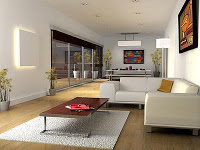Once you have met with your Architect, and given your requirements, he will design according to your Site size, budget and site conditions. The main things to look out for in the design solution are whether:
·The minimum, basic room sizes which are considered comfortable for use and for good furniture arrangement have been maintained. It is always important to have a comfortable sized Living room as the size cannot be changed later (unless you are prepared for large scale renovation). Even if you have a small site, it is not advisable to have a tiny Living room, because you will be forced to adjust to small, cramped living spaces for the rest of your life,
·All the planning considerations such as, furniture, clearances, space allowances, doors, windows etc for the Living room have been taken into account.
·The Living room location and orientation is according to the cardinal directions , so that it gets the right amount of Sunlight and air.
Here, I have explained the design considerations, furniture and the minimum basic sizes for a Living Room for your reference.
PLANNING CONSIDERATIONS FOR A LIVING ROOM:
· The principal factors to be considered in planning the Living Room are:
· Number of persons to be seated or entertained.
· Seating arrangement.
· Size of Furniture
· Space allowance for furniture.
· Space around the furniture for passage and accessing.
· Traffic Passage between Main door and doors leading to other rooms.
FURNITURE- A living Room has mainly furniture for seating, conversation and Viewing TV. Typically, there will be the main, primary conversation group and a smaller, secondary conversation group. Here, I have described the normal sizes of the furniture in a Living room. However furniture sizes may vary slightly.
· Sofas - Two Seater Sofas- 4'6" x 2'6",
· Three Seater Sofas -7'0" x 3'0", or 6'6" x 2'6" and
· Single Seater Sofa - 2'6" x 2'6" or 2'3" x 2'3"
· Armchairs - 2'0"x 2'4", 2'3" x 2'4"etc
· Sofa cum bed or Divan - 2'6" x 7'0"
· Centre Table - Rectangular- 2'0" x 1'3", 3'0" x 2'0" etc
· Circular- 3'0" dia., 2'6" dia.
· Side Table - Square- 1'8"x1'8", 1'6"x1'6"; Circular- 2'0" dia, 1'8" dia.
· Show case or TV/Music Unit - 4'0" to 5'0" in length and around 1'6" wide.
· Card Table - 3'0" x 3'0"
· Piano - Grand - 9'0" x 5'0", 7'0" x 5'0", 6'0" x 5'0", 5'6"x 5'0";
· Piano Rectangular - 5'0" x 2'0", 4'8"x1'7"
SPECIFIC SPACE ALLOWANCES:- When designing, adequate floor space should be provided for the furniture groupings. Certain clearances are required between the furniture pieces. Planners have established the minimum distances for comfort as well as the maximum distance for comfortable conversations. They are listed below:
· It is advisable to have minimum of 5' between opposite sofas and a maximum of 6' for comfortable conversation.
· A minimum space of 2' should be kept where circulation occurs between tall furniture.
· At least 1'6" should be kept when circulation occurs between low furniture.
· A minimum of 3' is required behind an occupied chair, to permit a person to pass by.
·At least 5' distance should be kept between the TV and the seating for comfortable viewing.
·Seating arranged around a 10' diameter circle makes a comfortable grouping for conversation.
FLEXIBILITY - The Living room should have flexibility, in that, one should be able to put it to various uses, like sleeping, dining, recreation, family etc. This is possible by having adaptable furniture. For example, a sofa can be converted into a bed, or a divan can be used as a bed if required when there are extra guests.
CLEARANCES-Traffic tolerances in a Living room are important, since a number of people use this room. and narrow lanes between furniture group are uncomfortable. Some basic minimum clearances must be considered:
· An adequate traffic lane between the main entrance and the major seating group should be provided - at least 3'4" but preferably 4'6". For bigger rooms, it is advisable to have a even wider traffic lane.
· Through traffic should be separated from the furniture groups as much as possible, so that one does not have to walk through the group to go to another room.
· The main traffic lane through the room should be a minimum of 3'4" though 4'6" is preferred.
LOCATION OF LIVING ROOM:
The Living room is the space where guests are entertained and the first impression is made. In many houses, it is also a kind of Family room, where the family sits together to watch TV or have discussions. The Location of a Living room depends on factors like the main Road, the Foyer, the main entrance door, orientation etc.
The Living room is the space where guests are entertained and the first impression is made. In many houses, it is also a kind of Family room, where the family sits together to watch TV or have discussions. The Location of a Living room depends on factors like the main Road, the Foyer, the main entrance door, orientation etc.



